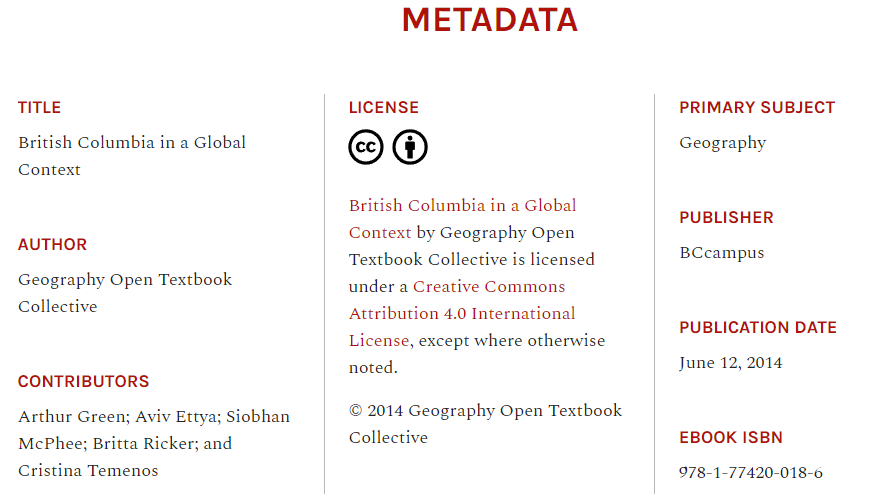Developing the Release Plan – Access & Metadata
Making Your Text Accessible
While there are several ways to share your text once you have created and licensed it, you may need a permanent location for your text to reside. Posting the text to a repository is a great way to increase the accessibility and audience for your materials, in addition to providing a stable space for your resource to reside. Additionally, some spaces where you will share your content (e.g. OE collections, databases, etc.) will need to link to the location where your text can be viewed and downloaded as they don’t provide this option for you.
Some repositories that allow for uploading of open texts include:
cIRcle
UBC Library has an institutional repository, cIRcle, which is UBC’s open-access digital repository for published and unpublished material created by the UBC community and its partners, including faculty, students, and staff. Its aim is to showcase and preserve UBC’s unique intellectual output by making the content freely available to anyone, anywhere via the web.
Sharing your work in cIRcle provides the following benefits:
- Support for submitting and indexing to make your content easily findable.
- Indexing in high-profile search engines such as Google as well as academically focused search engines and collections such as Google Scholar and OAIster, making it quick and easy for scholars and others to find your work.
- Archiving of your work for the long term. cIRcle provides permanent URLs so the links to your materials will remain the same over time.
MERLOT
The MERLOT collection consists of tens of thousands of discipline-specific learning materials, learning exercises, and Content Builder webpages, together with associated comments, and bookmark collections. These materials have been contributed by the MERLOT member community who have either authored the materials or who have shared existing open education materials. Materials in MERLOT are reviewed for suitability for retention in the collection. Many undergo the more extensive peer review process for which MERLOT is known. MERLOT has also added a “Smart Search” function which searches for OER at other libraries/repositories, and which can also search the web using a proprietary MERLOT user profile design to find the newest and most popular learning materials available.
Developing Metadata
Before distributing your textbook you will need to develop a standard metadata structure. Metadata is structured descriptive information that describes your resource. This information will be used when you upload and share your OER. Each place you will share your OER may have different metadata requirements.
Example – Open Textbook Metadata

The open textbook, British Columbia in a Global Context, is a first-year geography textbook takes a holistic approach to geography by incorporating elements of physical, human, and regional geography, as well as bringing in methods and perspectives from spatial information science.
The metadata fields required to publish the book in Pressbooks, including an abstract not seen here, can be found in the above image.
Standard Minimum Metadata for Open Textbooks
The following are the most common metadata fields that appear in OER repositories and catalogues.
Metadata Downloadable Template
The Metadata Template [Word] provides you with the most common metadata fields for OER. Fill out the template for your open text and use the metadata for sharing in OER repositories and collections.
Media Attributions
- Pressbooks Metadata © Stuart MacKinnon; Katie Burles; Terence Day; Fes de Scally; Nina Hewitt; Crystal Huscroft; Gillian Krezoski; Allison Lutz; Craig Nichol; Andrew Perkins; Todd Redding; Ian Saunders; Leonard Tang; and Chani Welch is licensed under a CC BY-NC-SA (Attribution NonCommercial ShareAlike) license
structured descriptive information that describes your resource.

